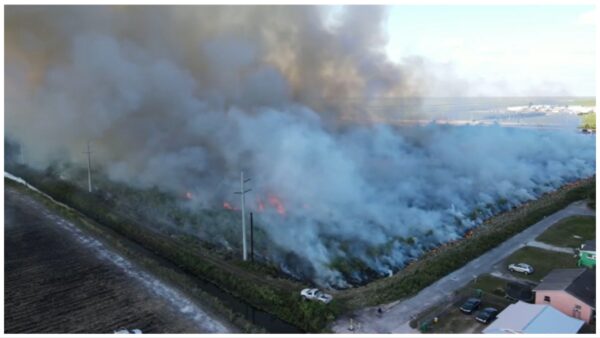Sugar cane burnings in parts of South Florida are spewing what’s been dubbed “black snow” in the air that makes it difficult for residents in the predominantly Black and Latino communities that surround the fields to breathe.
An NBC News report described the effects of the ash that is generated from the process of burning sugar cane. In an annual preharvest practice, sugar companies and farmers are legally allowed to set fire to their fields from October to May each year to leave only the cane, making it easier to yield after. The practice reportedly reduces transportation costs so that farmers can harvest and ship the cane without the leaves on the cane stalks.
Many of the burnings in Florida are clustered around the southern shore of Lake Okeechobee in the cities of Belle Glade and Pahokee, which are located in Palm Beach County, and the city of Clewiston in Hendry County. These areas are populated by majority Black and Latino communities, with many residents living in poverty. They have been voicing complaints for decades about the ash raining down on their cars, and yards, and even making its way through their home ventilation systems to end up in laundry units.

Florida State University researchers conducted a study last year that examined the effects of the ashfall on air quality and what circumstantial health detriments could arise from the burnings. Researchers discovered that one to six people die each year due to exposure to fine particles in sugar cane smoke.
Part of the findings also read that those “unhealthful particles” can be inhaled deep into the lungs and are connected to health issues like asthma, lung cancer, and cardiovascular issues. Researchers also discovered that mortality rates from exposure to these particles are “almost 10 times higher for residents living next to the fields as opposed to outside of the immediate area.”
The Sierra Club, a worldwide grassroots environmental group, found that burn regulations based on wind direction reveal that more affluent, white communities are spared from the ash when the wind blows their way.
The U.S. Sugar Corporation has previously concluded, based on their data, monitoring, and regulations, that the air in sugar farming communities is safe and meets all state and federal clean-air standards. The American Lung Association also rated the air quality in Palm Beach County as “grade A” in their 2023 State of the Air Report. Hendry County was not included.
Florida regulators were forced to upgrade their monitoring equipment in 2021 when a joint investigation by The Palm Beach Post and ProPublica found deficiencies in the state’s air quality monitoring technology, which compromised the enforcement of Clean Air Act standards.
FSU reports that more than two million acres of cane fields are burned each year across the state, which helps lessen the chances of wildfires and preserves natural habitats for certain species. “However, 400,000 of those acres are burned before harvest to remove non-sugar vegetation on the sugarcane stalk,” according to FSU’s study.
Sugar farming brings significant money to South Florida. Industry companies employ 14,000 people, and the industry as a whole generates approximately $800 million in revenue each year.
In 2019, residents joined forces to file a class-action lawsuit to halt the practice entirely, claiming the burns reduce air quality and reduce the property values in surrounding communities. That suit was dropped by the plaintiffs in 2022 with prejudice, which means it cannot be refiled in the Southern District of Florida. Future legal complaints might be compromised because of the dismissal. State lawmakers also passed an update to Florida’s Right to Farm Act in 2021 that blocks residents from suing farmers over “particle emissions,” which covers emissions from sugarcane burns.
Other countries that are mass producers of sugar are working to phase out the farming practice entirely.
NBC News spoke with CROPS Carbon International. CEO David Mitchell in Ireland identified a method to store refuse from sugar cane deep in the ocean and said the costs to transport the trash to the deep sea are nominal.
A ProPublica report found that Brazil, the world’s largest sugar cane producer, enacted legislation in 2002 to gradually rid the country of sugar field burnings over 30 years. To replace the practice, producers invested in harvesting equipment that allowed them to cut the cane without burning.
Weeding out this practice has actually brought about some drastic results.
The dry sugar cane leaves that were once burned form a protective blanket on the fields and enrich the soil. The leaves can even be used to generate renewable energy.
Burnings are still allowed in Brazil until 2031 in some parts of the country where vegetation is too thick to cut with machinery.
Florida’s Stop The Burn movement, which is led by residents who are most impacted by the sugar field burnings, is campaigning for a similar practice to be brought to Florida. They’re promoting “green harvesting” tactics where mechanical harvesters are used to mechanically separate sugarcane leaves and tops from the stalk. Then farmers and companies can leave the unused parts of the stalk as mulch or use it as a clean energy source.


